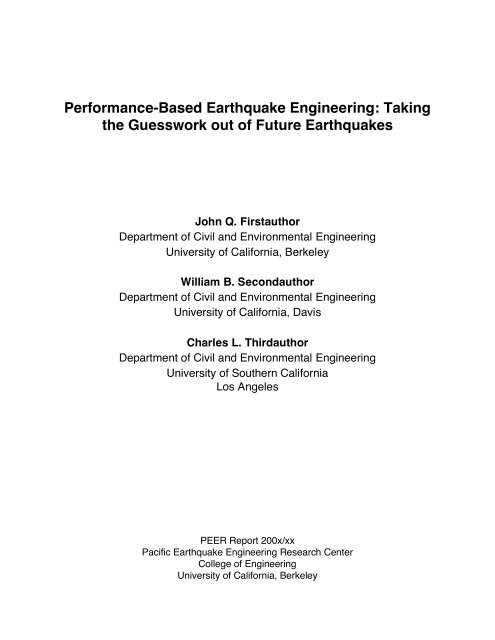Performance-Based Earthquake Engineering - PEER - University of ...
Performance-Based Earthquake Engineering - PEER - University of ...
Performance-Based Earthquake Engineering - PEER - University of ...
Create successful ePaper yourself
Turn your PDF publications into a flip-book with our unique Google optimized e-Paper software.
<strong>Performance</strong>-<strong>Based</strong> <strong>Earthquake</strong> <strong>Engineering</strong>: Takingthe Guesswork out <strong>of</strong> Future <strong>Earthquake</strong>sJohn Q. FirstauthorDepartment <strong>of</strong> Civil and Environmental <strong>Engineering</strong><strong>University</strong> <strong>of</strong> California, BerkeleyWilliam B. SecondauthorDepartment <strong>of</strong> Civil and Environmental <strong>Engineering</strong><strong>University</strong> <strong>of</strong> California, DavisCharles L. ThirdauthorDepartment <strong>of</strong> Civil and Environmental <strong>Engineering</strong><strong>University</strong> <strong>of</strong> Southern CaliforniaLos Angeles<strong>PEER</strong> Report 200x/xxPacific <strong>Earthquake</strong> <strong>Engineering</strong> Research CenterCollege <strong>of</strong> <strong>Engineering</strong><strong>University</strong> <strong>of</strong> California, Berkeley
Month 200xii
ABSTRACTThe abstract should be not more than 200 words and should include the context, contents, andconclusions <strong>of</strong> the report.A list <strong>of</strong> keywords is optional. It should be restricted to no more than six words that donot appear in the title.iii
ACKNOWLEDGMENTSA contractual agreement with the National Science Foundation requires one <strong>of</strong> the followingacknowledgment statements without alteration:This work was supported primarily by the <strong>Earthquake</strong> <strong>Engineering</strong> Research CentersProgram <strong>of</strong> the National Science Foundation under award number EEC-9701568 through thePacific <strong>Earthquake</strong> <strong>Engineering</strong> Research Center (<strong>PEER</strong>).Any opinions, findings, and conclusion or recommendations expressed in this materialare those <strong>of</strong> the author(s) and do not necessarily reflect those <strong>of</strong> the National ScienceFoundation.ORThis work was supported in part by the <strong>Earthquake</strong> <strong>Engineering</strong> Research CentersProgram <strong>of</strong> the National Science Foundation under award number EEC-9701568 through thePacific <strong>Earthquake</strong> <strong>Engineering</strong> Research Center (<strong>PEER</strong>).Any opinions, findings, and conclusions or recommendations expressed in this materialare those <strong>of</strong> the author(s) and do not necessarily reflect those <strong>of</strong> the National ScienceFoundation.For research supported by other sources but making use <strong>of</strong> <strong>PEER</strong> shared facilities,the following statement is required:This work made use <strong>of</strong> the <strong>Earthquake</strong> <strong>Engineering</strong> Research Centers Shared Facilitiessupported by the National Science Foundation under award number EEC-9701568 through thePacific <strong>Earthquake</strong> <strong>Engineering</strong> Research Center (<strong>PEER</strong>).Any opinions, findings, and conclusion or recommendations expressed in this materialare those <strong>of</strong> the author(s) and do not necessarily reflect those <strong>of</strong> the National ScienceFoundation.iv
CONTENTSABSTRACT............................................................................................................................. iiiACKNOWLEDGMENTS........................................................................................................ivTABLE OF CONTENTS ..........................................................................................................vLIST OF FIGURES ................................................................................................................viiLIST OF TABLES ...................................................................................................................ix1 INTRODUCTION.............................................................................................................11.1 The Importance <strong>of</strong> Nonstructural <strong>Earthquake</strong> Costs.....................................................11.2 Previous Research.......................................................................................................32 MODELING LOSSES: INPUTS AND OUTPUTS ........................................................52.1 Impact Models and the Southern California Planning Model (SCPM-2)......................52.2 The Elysian Park Scenario ..........................................................................................62.3 Losses by Location and Type......................................................................................62.4 Income Distribution Impacts.....................................................................................142.4.1 Descriptive Socioeconomic Analysis <strong>of</strong> Affected Cities ................................152.4.2 Identification <strong>of</strong> Social Subgroups Using Multiple SocioeconomicVariables.......................................................................................................152.4.3 Income Distribution Impact Analysis: Gini Coefficients...............................182.5 Descriptive Results ...................................................................................................203 CONCLUSIONS AND POLICY IMPLICATIONS......................................................39REFERENCES........................................................................................................................41APPENDIX A..........................................................................................................................43APPENDIX B..........................................................................................................................51v
Document Setup (Word)Table <strong>of</strong> Contents Tabsvi
LIST OF FIGURESFig. 2.1Fig. 2.2Fig. 2.3Los Angeles and Orange counties by census tracts......................................................7Direct impact (opportunity cost <strong>of</strong> production, $1,000) by city, SCAGPlanning Region........................................................................................................11Total impact ($1,000) by labor’s city <strong>of</strong> residence, SCAG Planning Region..............12vii
viii
LIST OF TABLESTable 1.1Joint design example for Specimen B1......................................................................3ix
1 Sample Chapter Title for <strong>PEER</strong> Reports1.1 SECTION HEAD LEVEL 2Sepe humanos affectus aut provocant aut mittigant amplius exempla quam verba (Author 1997).Unde post nonnullam sermonis ad presentem habiti consolationem, de ipsis calamitatum mearumexperimentis consolatoriam ad absentem scribere decrevi, ut in comparatione mearum tuas autnullas aut modicas temptationes recognoscas et tolerabilius feras.Patrem autem habebam litteris aliquantulum imbutum antequam militari cinguloinsigniretur; unde postmodum tanto litteras amore complexus est, ut quoscumque filios haberet,litteris antequam armis instrui disponeret.1.1.1 Section Head Level 3Ego igitur, oppido quodam oriundus quod in ingressu minoris Britannie constructum, ab urbeNamnetica versus orientem octo credo miliariis remotum, proprio vocabulo alatium appellatur,sicut natura terre mee vel gemeris animo levis, ita et ingenio extiti et ad litteratoriam disciplinamfacilis.Tunc ego Melidunum reverses scolas ibi nostras sicut antea constitui; et quantomanifestius eius me persequebatur invidia tanto mihi auctoritatis amplius conferebat iuxta illudpoeticum, “Summa petit livor, perflant altissima venti.”1.1.1.1 Section Head Level 4Ego igitur, oppido quodam oriundus quod in ingressu minoris Britannie constructum, ab urbeNamnetica versus orientem octo credo miliariis remotum, proprio vocabulo alatium appellatur,
sicut natura terre mee vel generis animo levis, ita et ingenio extiti et ad litteratoriam disciplinamfacilis.22a 2 + b = c(1.1)Patrem autem habebam litteris aliquantulum imbutum antequam militari cinguloinsigniretur; unde postmodum tanto litteras amore complexus est, ut quoscumque filios haberet,litteris antequam armis instrui disponeret.Table 1.1 Table title for reportsPatrem autem habebam litteris aliquantulum imbutum antequam militari cinguloinsigniretur; unde postmodum tanto litteras amore complexus est, ut quoscumque filios haberet,litteris antequam armis instrui disponeret .Fig. 1.1 Shaking table test for geotechnical project2
REFERENCESAbove all, be consistent. For example, don’t combine uppercase with lowercase style <strong>of</strong>capitalization: use one or the other. The following examples in the technical, or “down,” style <strong>of</strong>capitalization are typical entries for a (a) journal, (b) book or monograph, (c) report, (d) paperfrom a proceedings, and (e) chronological ordering <strong>of</strong> works by the exact same author(s). In thisstyle, titles <strong>of</strong> journals and proceedings, (and proper nouns) are capitalized.(a) Anderson, J. C., and V. V. Bertero. 1987. Uncertainties in establishing design earthquakes. J.Structural <strong>Engineering</strong> 113(8): 1709–24.(b) Clough, R. W., and J. Penzien. 1993. Dynamics <strong>of</strong> structures. New York: McGraw-Hill, Inc.(c) Gilani, A. S., A. S. Whittaker, G. L. Fenves, and E. Fujisaki. 1998. Seismic evaluation <strong>of</strong> 196kV porcelain transformer bushings. Report <strong>PEER</strong> 1998/02. Berkeley, Calif.: Pacific <strong>Earthquake</strong><strong>Engineering</strong> Research Center, <strong>University</strong> <strong>of</strong> California.(d) Hamburger, R. O. 1996. Implementing performance-based seismic design in structuralengineering practice. In Eleventh World Conference on <strong>Earthquake</strong> <strong>Engineering</strong>, Acapulco,Mexico, 1425. New York: Elsevier Science Ltd.(e) Makris, N., and S. P Chang. 2000. Response <strong>of</strong> damped oscillators to cycloidal pulses. J.<strong>Engineering</strong> Mechanics 126(2): 123–31.Makris, N., and S. P. Chang. 1998. Effect <strong>of</strong> damping mechanisms on the response <strong>of</strong> seismicisolated structures. Report <strong>PEER</strong> 1998/06. Berkeley, Calif.: <strong>University</strong> <strong>of</strong> California.3
Appendix A:Building <strong>Performance</strong> in Recent<strong>Earthquake</strong>s5
















